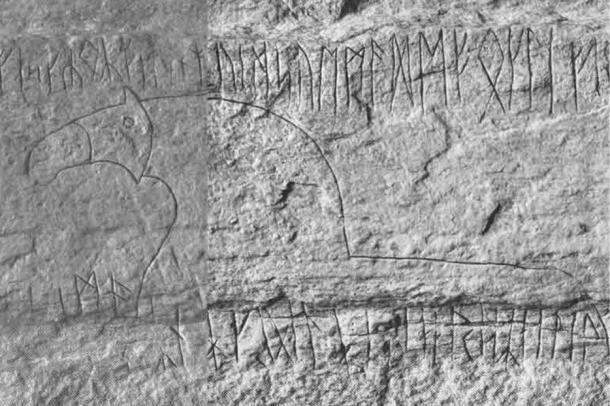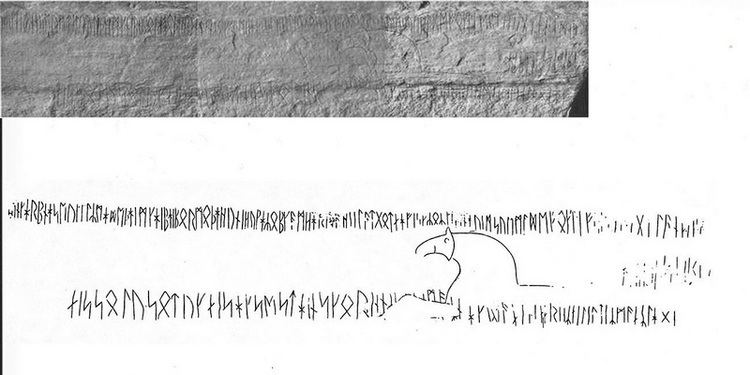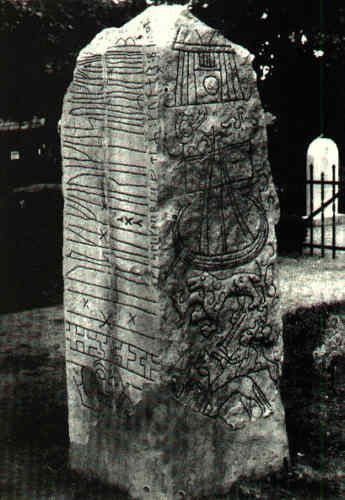 | ||
The Eggja stone (also known as the Eggum or Eggjum stone), listed as N KJ101 in the Rundata catalog, is a grave stone with a runic inscription that was ploughed up in 1917 on the farm Eggja in Sogndal, Sogn og Fjordane county, Norway.
Contents

Description

The Eggja stone was found with the written side downwards over a man's grave (cf. the Kylver stone) which is dated to the period 650-700 C.E. The flat slab of stone is nowadays in Bergen Museum. Having as many as 200 runes, it is the longest known inscription in the Elder Futhark, but certain runes are transitional towards the Younger Futhark.

Many scholarly works have been written about the inscription, but only minor parts of the partially preserved inscription have received an accepted translation. It is generally agreed that it is written in stylized poetry and in a partly metrical form containing a protection for the grave and the description of a funerary rite. However, there are widely diverging interpretations about certain details.
There is also the image of a horse carved into the stone, but it does not appear to have any connection with the inscription.
Transliteration
Standardized Norse spelling

Translation
One suggested translation:

Suggested interpretation: The stone has been prepared in accordance with tradition; the stone is untouched by sunlight, and not cut with iron. It should not be uncovered during the waning moon, and should not be removed from its place.

Someone has stained this stone with blood (kenned as corpse-sea); perhaps as part of a sacrifice to facilitate the passage of the deceased or call on whatever power the inscription is addressed to. The hæráss is the "god of armies" - a psychopomp god which comes to the land of the living (godly ones) to take the deceased to an afterlife. Most likely the shapeshifting, shamanic áss Odin is meant, but the Christian god has absorbed this kenning in later Norse poetry.
The meaning of the alu formula is uncertain, as are the runes spelling it out. See reference sources for more possible translations.
Another suggested translation:
A more prosaic interpretation (offered by Ottar Grønvik) (1985):
A1 (hiu þwer) hin warp naseu wilʀ made þaim kaiba i bormoþa huniA2 huwaʀ ob kam harie a hit latA3 gotna fiskʀ oʀ firnauim suwimade foki af (f)a(nwan)ga landeB a(i a)u is urkiC1 ni s solu sot uk ni sakse stain skorinC2 ni (witi) maʀ nakdan is na wrinʀ ni wiltiʀ manʀ lagi(s)(Parenthesis denotes reconstructed or anticipated forms)
The Old Norse equivalent is here said to be:
A1 Hjú þverr, hín varp násjó *Vill: máðe þeim keipa i bormóða húni.A2 Hverr of kom her á hitt land?A3 Gotna fiskr ór firney-ím, svimande foki af fán-vanga lande.B Æ ey es yrki!C1 Ne's sólu sótt, ok ne sakse, stein skorinn;C2 ne víti maðr, nǫkðan es ná rinn, ne viltir menn, lægis!Translation:
A1 The household wanes, *Vil threw a death wave over thoseThe oarlocks wore out for, with the tired mast-topA2 Who brought the horde to the land afar?A3 The godly-fish from Firnøy’s streamsSwimming in the drift of the land of shining meadows.B Be it of help, I work this.C1 Not has the sun seen, nor the sword shorn, this stone,C2 Do not seek who call forth the naked dead,Nor wildly men, this bed of rest!According to this interpretation, A1 is a description of a shipwreck in bad weather. The mast seems to have broken, and the oars could not save them, as a mythical creature, *Vil (possibly the sea-god Aegir, or simply divine will,) casts a wave upon the boat. Parts A2, A3 and B explains the fate of the deceased. As A2 asks how they will get to the land beyond, A3 replies that a divine creature in the shape of a fish will lead them to the land of shining meadows. Part B prays that the work of the one writing this will help. Firney is probably not a place name, but possibly Fear-island or Far-island, and a kenning for the realm of the dead. Part C1 says that the inscription was done at night, and not by using steel. This probably pertains to ancient grave-rituals, but the exact meaning is unclear. C2 issues warning directed at necromancers and mad (or mentally ill) people to prevent them from desecrate the grave.
Meter
Panel 2 has been suggested to contain a stanza in the Galdralag meter, i.e.:
Huæaʀ of kam hæráss áhi á land gotna.Fiskʀ óʀ f(ir)na uim suim(m)ande,fogl á f??????? galande.Whom as came harrier-godhere to goð 's land?Fishlike, out of river-fear swimming,as fowl, out of f(?) crowingThe inscription loosely follows the pattern of the Merseburg Incantations, divided into two complementary parts, but where the Merseburger invokes a mythic event and calls for an exorcistic repetition, the Eggja composer seems to twice invoke a ritual, the first time listing two desired outcomes, in the second instance asking a question and answering it. Both inscriptions may represent some of the few remaining examples of pre-Christian ljoð or galdr, ritual verse chanted by the cult leaders, shamans or oracles of Norse Scandinavia.
The name Eggja/Eggum
The Norse forms of the name was Eggjar (nominative) and Eggjum (dative). The name is the plural of egg f 'edge; mountain ridge' (compare Besseggen). The form used on modern official Norwegian maps is Eggja.
